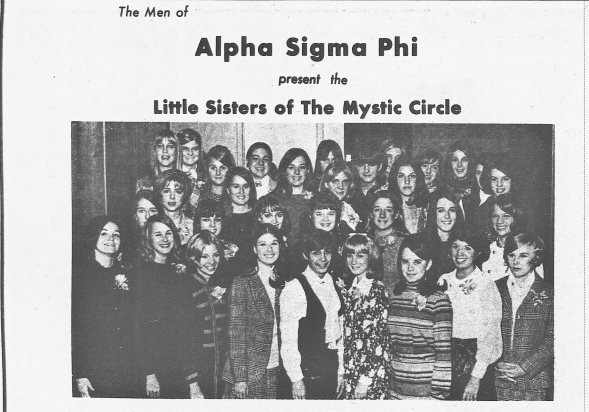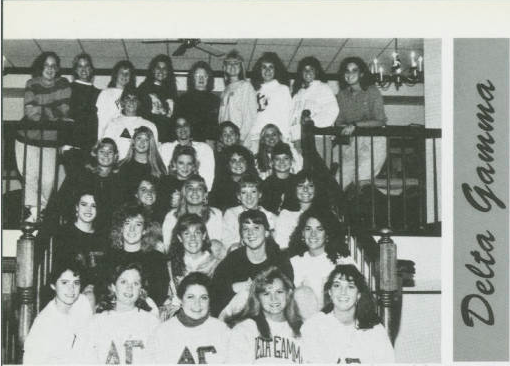Posted on November 26, 2019 by small20
Sorority Life on Campus 1960-2000
by Anna Brown
“Overall our sorority house felt like a home, with really nice and kind girls. I lived in a home with a lot of friends, I was not best friends with all of them, but I always felt welcome there.”(1) Sorority living was and is designed for women to come together and encourage each other in their academic and life pursuits. This was especially true on campuses where male students outnumbered the female students. The Purdue sorority and fraternity community began first with fraternities. Sigma Chi was the first fraternity, chartered in 1875. The first sorority came forty years later in 1915. Kappa Alpha Theta was the first sorority on Purdue’s campus. (2) The Greek system is known for supporting other houses philanthropies, competing in intramural sports, and throwing social gatherings. The narratives of Greek members and various documents from the 1960s to the turn of the century prove there are stories that go beyond the good intentions and fond memories of living with best friends. The Greek system at Purdue, although prominent and perhaps more conservative than other universities had inappropriate behaviors and events that made light of and perpetuated women’s struggles.
Philanthropies play a critical role in sorority life. National sorority houses support specific charitable foundations through money raised by fundraisers put on by chapter houses. However, some philanthropies, according to Janalee Brown, were inherently sexist. Brown described an event sponsored by her sorority to raise money. “We auctioned ourselves off to the highest bidder, to a fraternity, for a fundraiser. We literally walked down a runway in the fraternity. When the girl walked down, we would talk about how these women could do chores for the guys: laundry, be a study buddy, help edit a paper, make you a dinner.”(3) This is an example of women being objectified to raise money for a philanthropy. Other activities within sororities and fraternities from the 1980s also objectified women. Brown described a “Best Body”competition between sororities at Purdue.(4) Each sorority house selected two women to represent their house in the “Best Body” competition. The competition included a swimsuit category among others. Although each sorority house participated, Brown personally believed, “It was so stupid and wrong.” (5) This objectification of women on campus was a recurring problem addressed in the Purdue Exponent by a Purdue student, Jill Gleeson. “It is evident from these examples[of beauty pageants on campus] the objectification of a woman’s beauty and sexuality is considered OK by the student body. This is true of both the male and female population.”(6) A decade later at Purdue, in the late 1990s, Nicole Meneley, a member of a sorority at Purdue, attested to other inappropriate philanthropies put on by fraternities that many sorority women were not comfortable participating in, including, “mud wrestling and jello wrestling,” (7) The main difference between the eighties and nineties was the degree of participation of the sorority women in these objectifying fundraisers. In the nineties, there was less participation. “Sometimes girls would participate sometimes they were like ‘No, we are not doing that.’ I think every woman in the chapter was okay with it [the women not participating].” (8.) Regardless, these kinds of fundraisers existed and reveal a lack of respect towards women from fraternity men.
Parties, or functions, as we call them today, were until the twenty-first century, called “keggers.”(9) The social aspect between sorority and fraternity houses have deep roots in the party culture. Barbara MacDougall described the keggers and social scene of the early 1970s as an activity decided on by the sorority members. Fraternities would extend invitations and according to MacDougall, “The house would elect to go or not go.”(10) Julie Wainwright, a sorority member in the mid-seventies described examples of various activities that went on at parties. “There were wet tee shirt contests. The fraternities had a goal to get girls drunk.”(11) Similarly in the 1980s, Brown remembers specifically the lack of safety at parties and crude themes. One theme of a fraternity party, Brown recalled, was especially appalling. “They had an orgy night. They literally put mattresses on the floor.”(12) The party culture of the Purdue greek system during the seventies and eighties especially was degrading towards women. These examples as described by sorority women were not uncommon instances. Rather, the regularity of events within the greek system points to a culture that consisted of sexist attitudes towards women.
The “Little Sisters” program was a system created in 1963 within the greek system at Purdue. (13) [insert Photo 1] As described in The Greek publication, “A major duty of little sisters is helping with rush by serving coffee or by being hostesses for rushees, or putting on skits.” (14) This system allowed fraternity men to rush a select group of women each year. These selected women became initiated members and essentially would spend time with the fraternity men at their house and perform domestic tasks. Wainwright recalled, “I was a Little Sister in a fraternity.” That was until Wainwright discovered, “They used to spank the girls as a part of initiation. I wouldn’t do it, it was humiliating and disgusting.”(15) She dropped out of that program once she saw this behavior. Brown also recounted her experience “rushing” a fraternity as a “Little Sister.” “It was explained that this program was a great way to meet others on campus. Everyone was friendly enough but it basically came down to guys picking girls they wanted to party with. I wanted nothing to do with any system, organized or not, that was based on outward appearances and being interviewed (nonchalantly of course) by a bunch of fraternity boys to see if I measured up for a good party.” (16) Confirmed through a 1983 article in the Purdue Exponent, “These parties can become meat markets when a small number of women compete for the prize of bedding the local brothers. Others are well-put together affairs (no pun intended) where the women are chosen in a tasteful manner.” (17) The “Little Sisters” programs began to fade out during the early nineties as the deeper implications became clear to Purdue’s greek members. The Purdue Exponent wrote an editorial in the early nineties describing the reality of program.“Some see the passing of Little Sister programs as a blessing because they view Little Sisters as nothing more than a sex slave for the fraternity, members. Whether this is true or not may never be answered now that the sisters are almost extinct.” (18) Amidst all the sexist activities that occurred between sororities and fraternities at Purdue were the positive experiences that members of sororities remember. Kathryn, interviewed while on vacation with three of her pledge sisters from 1970 remarked about sororities, “I find it is the best thing that can ever happen to a woman in college.” (19) The experience of living with friends and women that shared similar interests and values was important to women on campus. Even after discussing the problematic aspects of sorority life, Brown ended the conversation by stating, “I really liked being able to walk in at anytime and there was always something you could go do with any number of girls or just hang out. I was happy to see people and they’re happy to see you too. I really felt like our house was super friendly and nice, I always felt welcome. There was little drama.” (20) [Insert Picture 2] Positive experiences within philanthropic activities and sorority community was commented on frequently. Barbara MacDougall, a sorority member in 1970-74 only recalled the philanthropic activities involving the sorority’s national philanthropy–serving the visually impaired–not the inappropriate fraternity fundraisers. (21) MacDougall also discussed how sorority leaders met to discuss common problems and issues facing their sorority members and how to approach solving the problems.(22) Each woman interviewed remarked on positive experiences within greek life. The women who saw the problematic gender issues between sororities and fraternities did not participate. Sororities existed to promote women. Eventually the activities that did not promote women, like sexist or objectifying activities were ended.


- Janalee Brown, telephone interview by author, November 12, 2019.
- “Fraternities Started at Purdue 66 Years ago,” The Purdue Exponent, March 8, 1951, Vol. 66, No. 101, 3.
- Janalee Brown, telephone interview by author, November 12, 2019.
- Ibid.
- Ibid.
- Jill Gleeson, “‘Sexploitation’ is alive, well at this University,” The Purdue Exponent, April 19, 1985, Vol. 101, No. 65, 6.
- Nicole Meneley, telephone interview by author, October 15, 2019.
- Ibid.
- Barbara MacDougall, telephone interview by author, October 15, 2019
- Ibid.
- Julie Wainwright, telephone interview by author, October 29, 2019.
- Janalee Brown, telephone interview by author, November 12, 2019.
- The Greek, September 7, 1969.
- Ibid.
- Julie Wainwright, telephone interview by author, October 29, 2019.
- Janalee Brown, telephone interview by author, November 12, 2019.
- Mary Piantek, “Little Sisters: Open season on freshman women,” August 25, 1983, Vol.99, No. 101, 7.
- Editorial, The Purdue Exponent, August 31, 1990, Vol. 106, No. 116.
- Kathryn Nagel, telephone interview by author, October 15, 2019.
- Janalee Brown, telephone interview by author, November 12, 2019.
- Barbara MacDougall, telephone interview by author, October 15, 2019.
- Ibid.
Image References: Purdue Archives & Special Collections
Category: Women’s Place at Purdue, 1960-1990 Tags: 1960, 1970, 1980, 1990, 2000, College Fraternities, College Sororities, Little Sisters, Sexism